London Travel Guide
An unlimited pass for all your public transport journeys in London. Choose your zones and the duration, and travel as much as you want.

A Travelcard is a transport pass that gives you unlimited journeys on all London public transport . That includes the Tube , buses , DLR, London Overground , trams, and National Rail Services in the city.
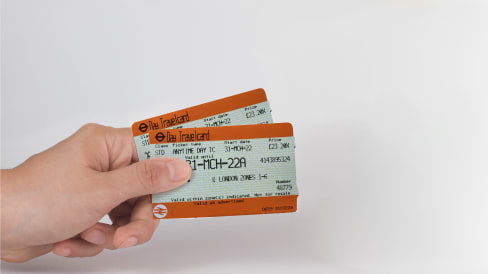

What is a Travelcard?
Travelcards are all-inclusive transport passes for London Transport, and they come in different duration options (1 day, 7 days, 1 month, 1 year, or even a custom period of any length between 1½ and 10½ months).
Travelcards also have several zone validities, but the one you are most likely to use is the zone 1-2 Travelcard, since this is where you’ll be spending the overwhelming majority of your time as a tourist. If you have a zone 1-2 Travelcard you can also use buses anywhere in London, regardless of the zone in which you are.
Many visitors get confused between Travelcards and Oyster cards , but the difference is quite simple. The Travelcard is a transport subscription , an unlimited pass, while the Oyster card is simply a physical support for travel credit . You can load any credit on an Oyster card and decide to use it for pay-as-you-go travel in the city, or you can also load a Travelcard on the Oyster.
In fact, you will need an Oyster card to load your weekly (or monthly or annual) Travelcard onto. On the other hand, if you get a daily Travelcard, it will be printed on a paper ticket.
If you want to know more about the Oyster card, its prices, and its benefits, you will find everything you need in our dedicated article.
How to use a Travelcard
Using a Travelcard on public transport in London is very easy. All you have to do it is have one Travelcard per person and make sure that it is valid before approaching the gates at an Underground station or when getting on the bus .
All you have to do is tap your card at the start of your journey and tap it again when exiting at your arrival station . Tapping upon exit is not necessary on bus or tram journeys. At Underground stations, the entrance gates have yellow card readers, while the readers on buses are usually by the driver’s cabin.
For the purposes of ticket validity, each day is considered to start at 4:30 am and end at 4:29 am the following day. This means that a weekly Travelcard activated on Monday will be valid until the following Monday at 4:29 am (the night going from Sunday to Monday).
Prices and fares are calculated on the basis of the zone system.
Zone system in London
For the purpose of public transport pricing, London is divided into 9 concentric zones. The first important thing to know about these zones is that the most central zones, where the majority of the attractions and monuments can be found, are zones 1 and 2 . These are the areas of the inner city where you will likely spend the majority of your time as a tourist . Here are some important sites you can find outside zone 1 and 2.
- Heathrow Airport - Zone 6
- Gatwick Airport - Zone 6
- Wembley Stadium - Zone 4
- Wimbledon (All England Lawn Tennis and Croquet Club) - Zone 3
- Hampton Court - Zone 6
Another important thing to note about these zones is that while the London Rails and Underground system (which includes the Tube, the DLR, and Overground) respond to this zone system in terms of pricing, London buses do not .
This means that even though London buses operate throughout the 9 zones, bus journeys always cost the same, no matter how many zones you travel through. It also means you can take a bus anywhere in London if you have a zone 1-2 Travelcard.
How much is a Travelcard?
The cost of a Travelcard is determined by its duration and zone validity. You also need to take into consideration that different Travelcards need to be loaded on different supports.
While a day-Travelcard is printed on a paper ticket , all other Travelcards (weekly, monthly, and annual) need to be loaded on an Oyster card which costs £7.00 (non-refundable).
There is no real 1-day Travelcard for zones 1-2 (or 1-3, for that matter). To cover those areas with a daily Travelcard you need to buy a zone 1-4 Travelcard, which costs £15.20. We do not recommend it, instead, you could use the pay-as-you-go service on Oyster or contactless .
7-day Travelcards, on the other hand, are much more convenient, costing £40.70 for zones 1-2, where you are most likely to spend your time as a visitor. In the following table, you can find the cost of all Travelcard subscriptions.
*Off-peak Travelcards are only valid for travel on Saturdays, Sundays, and Monday to Friday between 09:31 am and 3:59 pm, and from 7:01 pm to 06:29 am when using the Underground.
in London newsagents, or through the TfL Oyster app . If you have a UK bank account, you can simply reload your Travelcard online by logging into your Oyster account.
, and in some DLR stations.
Our recommendations
If you want to know more about the Oyster card and pay-as-you-go options, read our dedicated article.
Is buying a Travelcard in London worth it?
This depends on how long you will stay in London. Essentially, if you are in London for around a week, the Travelcard is absolutely worth it and much cheaper than all other transport options. If , on the other hand, you are in London for 5 days or less, it is better to use a pay-as-you-go system with a contactless payment method or an Oyster card .
In the table below, you can find a comparison of daily and weekly Travelcard prices and corresponding caps on pay-as-you-go fares. As you can see, there is no real 1-day Travelcard for zones 1-2 (or 1-3). To cover those areas with a daily Travelcard you would need to buy a zone 1-4 Travelcard, which costs £15.20. We do not recommend this, since the pay-as-you-go daily cap Oyster and contactless for zones 1-2 is only £8.10.
The weekly Travelcard instead, has the same price as the weekly cap on pay-as-you-go, which is £40.70 for zones 1-2 (only valid for contactless payment methods, not for Oyster cards). The advantage of the weekly Travelcard is that it applies to a natural week rather than a calendar week (Wednesday through the following Tuesday, for example).
On the other hand, the pay-as-you-go weekly cap on contactless payment methods can only be applied from Monday to Sunday. Therefore, if you are in London in between weeks (Thursday to the following Wednesday, for example), getting a Travelcard can save you quite a bit of money .
TfL Oyster and contactless app
The TfL Oyster and contactless app is a free app that helps you manage your London transport cards.
With it, you can renew your Travelcard and load it on your Oyster, check your journey history, and even top up your pay-as-you-go credit on your Oyster card or load Bus & Tram passes on it.
More related activities...

You might also be interested in...

Although quite small, London Stansted is one of the busiest airports in the UK, serving as the main airport for European flights in London.

5,000 years of decorative arts and design are housed in over 12.5 acres of Victorian and modern buildings at the Victoria and Albert Museum in London

The differences between Travelcards, Oyster cards, and contactless payment methods can seem confusing. Here you will find the advantages and disadvantages of each, as well as comparisons to determine the most convenient option for you.

Considered one of the most prestigious art collections in London, the Wallace Collection is housed in a late-18th-century townhouse

Always lively, colourful, and buzzing, London’s Chinatown is one of the city’s coolest neighbourhoods and a must-visit for all gastronomy lovers.
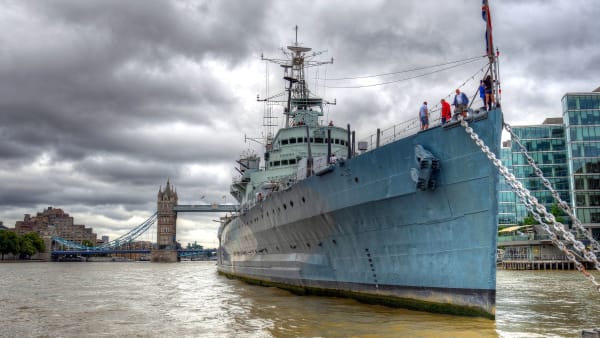
HMS Belfast is a ship-museum where you can discover how a 20th-century warship functioned in every aspect, from battles to medical emergencies to everyday life for the crew.

- Transportation
Travel Cards and Tariffs
The Travelcard is a paper ticket that gives you unlimited access to London’s public transport for a limited amount of time , being the best option for the majority of tourists.
You can either get a 24 hour or 7-day Travelcard . Residents can also get monthly or annual Travelcards.
When buying a 24 hour Travelcard, you can choose a Day Anytime , which can be used at any time of the day and is valid until 4:30 am the next day. Or you can get the Day Off-Peak , which only allows you to take public transport after 9:30 am and is also valid until the next day at 4:30 am.
Children under eleven can ride with an adult for free.
Where to buy a London Travelcard?
The Travelcards can be purchased at any tube station , tourist information stands, in the National Rail stations and also in certain newsagents .
Depending on where you purchase the ticket, you will get it in one format or other. In the tube stations, when buying a 7 day Travelcard, you’ll get it in a pre-charged Oyster Card .
If you get it in the National Rail station , you’ll get it as a paper ticket with the National Rail symbol on it , which is important if you want to use the 2FOR1 offers.
Travelcard or Oyster Card?
Although both cards are very similar, and the Travelcard can be bought within an Oyster card, from a touristic point of view, there are several differences:
- For a tourist an Oyster Card can be more troublesome : you have to buy it, recharge it and finally return it to be given back the money that you haven’t spent on it.
- If you buy a Travelcard in the National Rail (railway stations), you’ll have access to the 2FOR1 offers in London's top attractions .
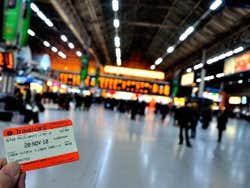
You may also be interested in
Is it cheaper to buy a London travel card? Learn how to save money when using the public transport network in London.
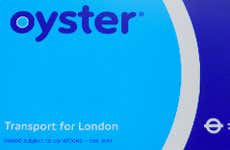
Oyster Card
The Oyster Card is a magnetic rechargeable plastic card valid for all of London’s public transport. It not only simplifies the payment system, but it's also cheaper than paying for a single journey ticket every time you ride the Underground, bus, DLR, or Overground.
This website uses cookies to improve your browsing experience and analyze the use of the website. Learn More

How to Use Buses in London

This post is a guide to riding the buses in London, including how to pay your fare and other helpful planning tips.
Bus travel in London is well worth considering during your travels in the city.
The buses are easy to take and run 24 hours a day.
- Ease of Use
- Payment Options
- Planning Your Trip
- Tips for Riding the Bus
The London bus network covers the entirety of the city too and gets you to places the tube might not reach.
And of course, you get a great view of this gorgeous city as you pass by many of the most well-known sights in London.
In fact, if you decide to do this, we have a self-guided bus tour that takes you past major icons like Westminster Abbey, Trafalgar Square, Covent Garden, and more.
EASE OF USE
Although there is a lot of information on this page, know that once your decisions are made about how you want to pay for your fare, the rest is rather easy.
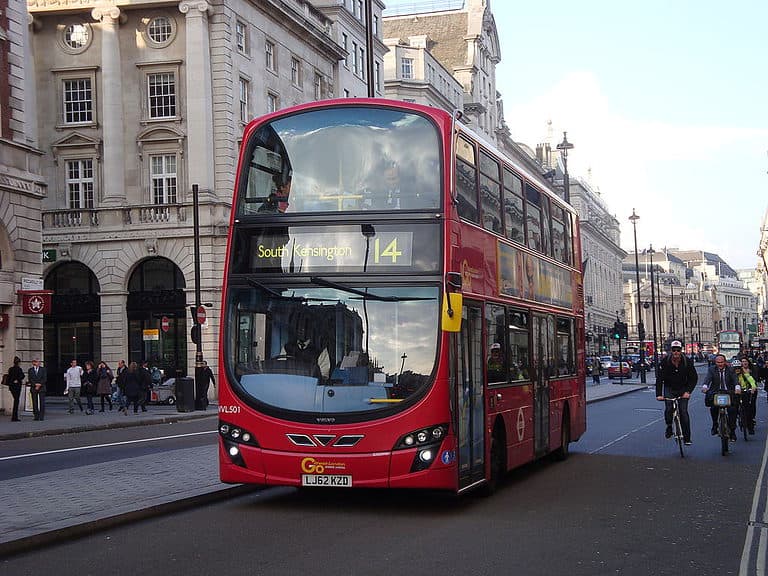
There are apps to help you with your route planning, and we’ve listed some travel helpful tips below.
Within only a few trips you’ll be an old hand at traveling by bus throughout London.
HOW TO PAY FOR YOUR FARE
You can pay for a bus ride by using a contactless card , a Visitor Oyster card , an Oyster Card , or a Travelcard .
You can’t pay for a bus ride with cash.
Contactless Cards
These are credit or debit cards (or devices) that can be tapped on a reader inside the bus to pay for a trip. On buses, you tap as soon as you board and there is no need to tap again as you alight.
Your bank card needs to show this symbol on it to tell whether it can make a contactless payment:
Credit or debit cards from outside the UK that sometimes allow contactless purchases are the AMEX (American Express), Mastercard, Maestro, Visa, and V Pay cards.
Note that it’s best to look into whether your bank will charge a transaction fee if you use this method.
Contactless cards are subject to the same price capping as an Oyster Card, so you never pay more than you would have spent had you purchased a daily travel card.
You are also able to take advantage of the 'Hopper' fare.
However, you won't get the same discounts available with the Visitor Oyster Card.
Oyster Cards
An Oyster Card is a plastic smart card, which is used to store money for rides throughout the London public transport system.
It also gives the holder *discounts on some attractions, restaurants, entertainment venues, and more.
There are two kinds of cards, the Visitor Oyster Card and the regular Oyster Card , both of which function fairly similarly.
Each is a pay-as-you-go pass, meaning your card is charged each time you make a trip, depending on the zone (there are 9 of them) and whether it is peak or off-peak time.
It also caps the fares on trips taken within a single day, making the cost cheaper than single-ticket purchases.
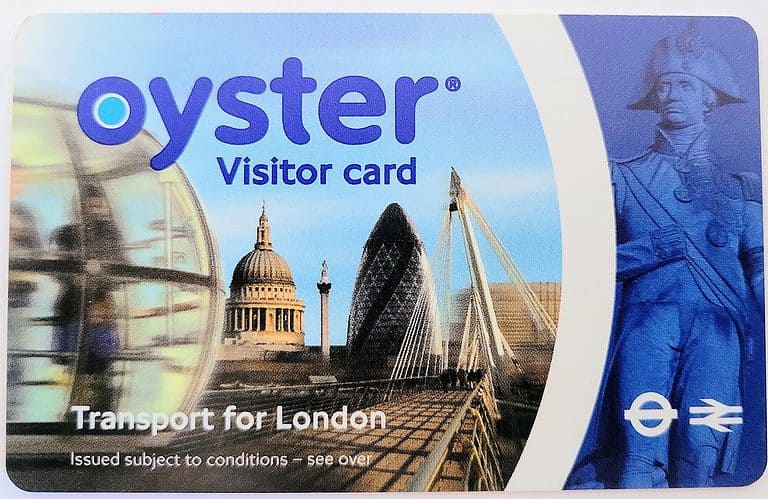
Both cards cover rides on buses, trams, the London Underground (Tube), DLR, London Overground, TFL Rail, most National Rail services in London, Emirates Air Line cable car, and River Bus services (MBNA Thames Clippers).
Each rider needs their own card, meaning a family cannot share a single card.
As far as costs go, there is a cost to buy the card itself, currently £7.00, in addition to the cost of whatever you put on the card.
But the card never expires, and you can top it up whenever you want to or need to.
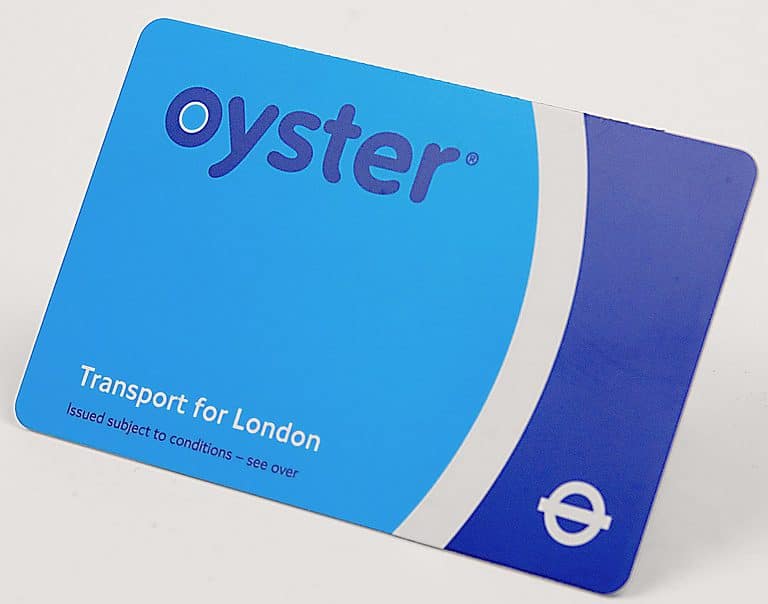
Speaking of topping it up, the card can be filled on an app, at over 4,000 local shops called Oyster Ticket Stops, at visitor Centres, at kiosks in tube stations, and many other places.
And for those who want to have the Oyster card on hand when they land at the airport, the Visitor Oyster Card can be purchased online and shipped to you ahead of time.
* None of the deals are that spectacular and you generally get much better discounts with a tourist attraction discount pass . The TurboPass, one of the tourist discount passes, includes a Visitor Oyster Card for free.
Travelcards are prepaid cards that give you unlimited access to specific zones within London.
Buses don't operate in "zones" and therefore any type of Travelcard will work on them.
However, if you are also taking other forms of transport, like the Tube, this might be of more use to you.
You can choose to either order these in advance (in which case you will be given a paper Travelcard) or you can buy them upon arrival (in which case you will be using a plastic Oyster Card with the travelcard loaded onto it).

There are many different lengths of Travelcards, but the most pertinent to visitors is the 1-Day Travelcard.
(There's also a 1 Month and 1-year ("annual") travelcard)
There's little reason you would ever need the 1-Day Travelcard as there is already a cap on Oyster Cards that limits the amount you can be charged per day.
In fact, you will likely lose money if you choose the 1-Day Travelcard over a regular Oyster unless you take advantage of the 2-for-1 tickets included.
Generally speaking, unless your accommodation is out in Zone 3 or higher, Zones 1-2 are probably all you will visit as a tourist.
There are a few fare options on London buses.
Fare Option 1: Hopper Fares
If a passenger plans to pay using a contactless credit/debit card or an Oyster Card, they are eligible for the Hopper fare.
The Hopper fare allows a rider to transfer from one bus (or tram) to another within an hour of touching your card for the first time. It also gives you unlimited journeys within that time frame.
You still have to tap your card each time you enter a new bus (or tram), but it does not charge you a second time.
As of December 2023, the cost of a Hopper fare is:
Adult: £1.75
Children aged 11-15: Discounted with Young Visitor Discount Oyster Card
Children aged 10 and under are Free with an adult
There is a daily cap for Hopper fares as well, which means that at most you’ll pay £4.95 per day.
For example, if you spend two hours on buses in the morning, one in the afternoon, and one in the evening, pricing will be capped once you reach £5.25.
The weekly cap is £24.70, so if you plan to be there for 5, 6, or 7 days, a Week Bus Pass that gets loaded on your Oyster card might be a good option.
But, it’s important to note that a One Week Bus Pass starts on a Monday and runs through a Sunday.
If you’re arriving on a Friday, for example, this would NOT be a good option as you would only get to use it for a few days.
Fare Option 2: One-Day Bus Pass
If you don’t have a contactless credit/debit card and don’t want to purchase an Oyster card, you can purchase a One Day Bus Pass.
The is a paper ticket that gives you unlimited travel until 4:29 AM the following day.
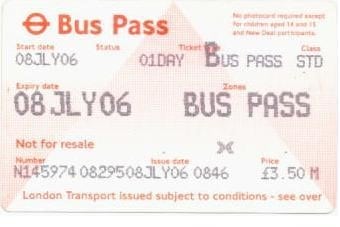
It can be purchased from many of the same places the Oyster card can be purchased at: Tube stations, Oyster card stores, train station ticket offices, and Transport for London Visitor Centres.
As of 2023, the cost for a One Day Bus Pass is £5.90.
PLANNING YOUR TRIP
There are a few resources that could help you plan your trip through London.
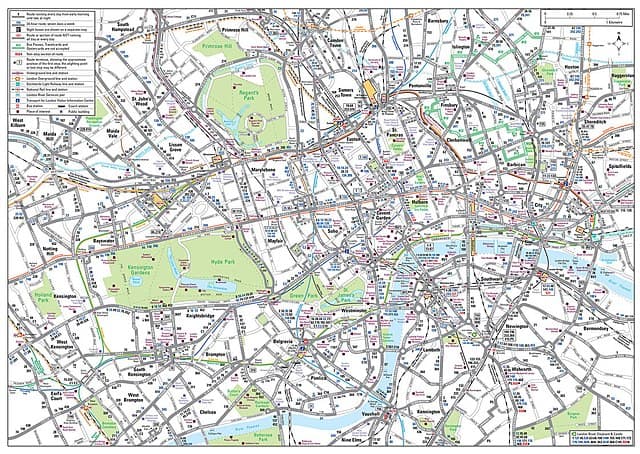
Plan a Journey Website
London Transports Plan A Journey website allows you to enter the names of well-known attractions or Tube stops.
It uses that info to build a route for you using public transport. It also provides options if you’d rather cycle or walk.
PDFs of Maps
For buses alone, you can download PDFs of specific bus maps (or spider maps, as they are called).
Examples of maps are London Bridge - Night Buses, London Zoo and Primrose Hill, and Tower of London.
These maps show you your destination and the various ways to get there including buses, the Tube, and National Rail.
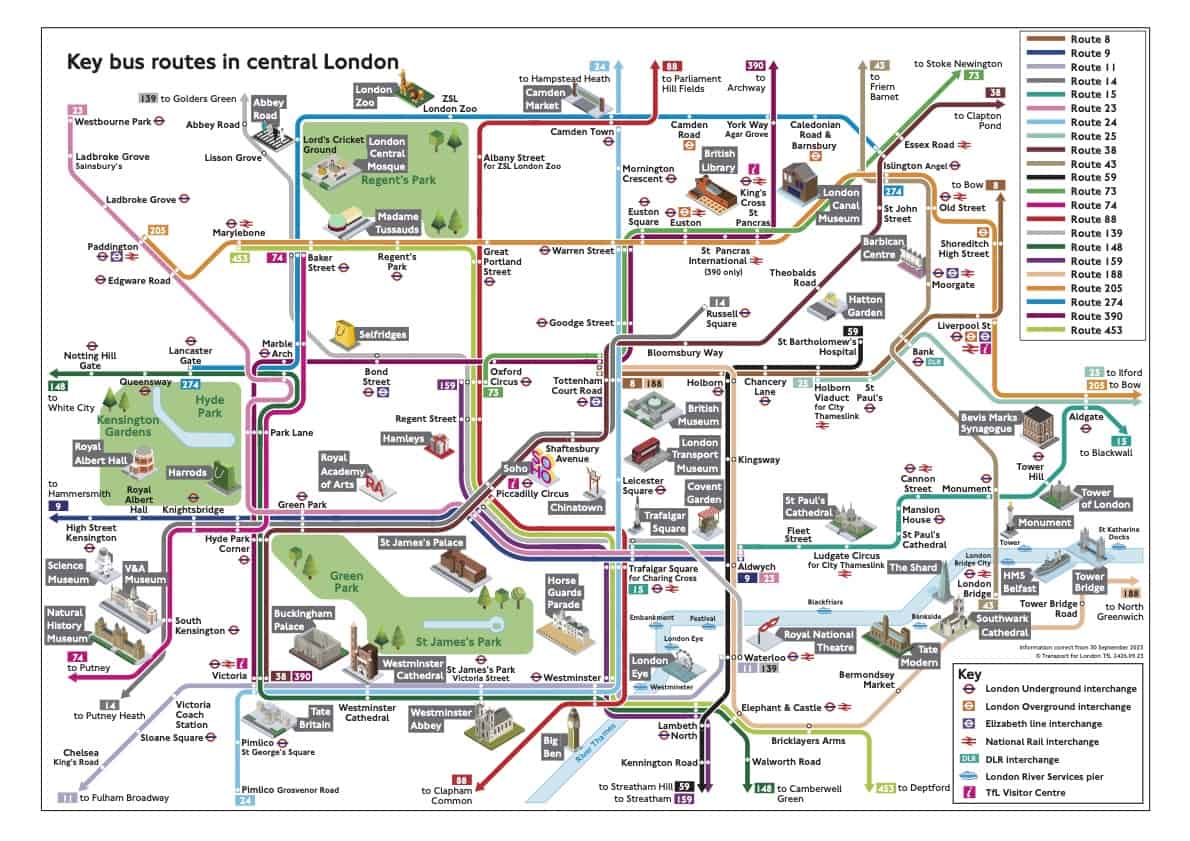
There are a few apps that might be worth downloading.
The TfL Go app allows you to plan your trip, see a live map of your route, and get updates on bus, train, and tram times.
The TfL Oyster and contactless app allows you to “top up or buy a ticket anytime” and check your journey history. It also warns you when your credit is low and your passes are expiring.
The Citymapper London app also gives you live up-to-the-minute updates on routes, offline maps, transport ticket prices, and more.
The Bus Times app will let you know when the next bus is arriving at any stop you wish to view.
TIPS FOR RIDING THE BUS
Here are some tips for riding a bus in London.
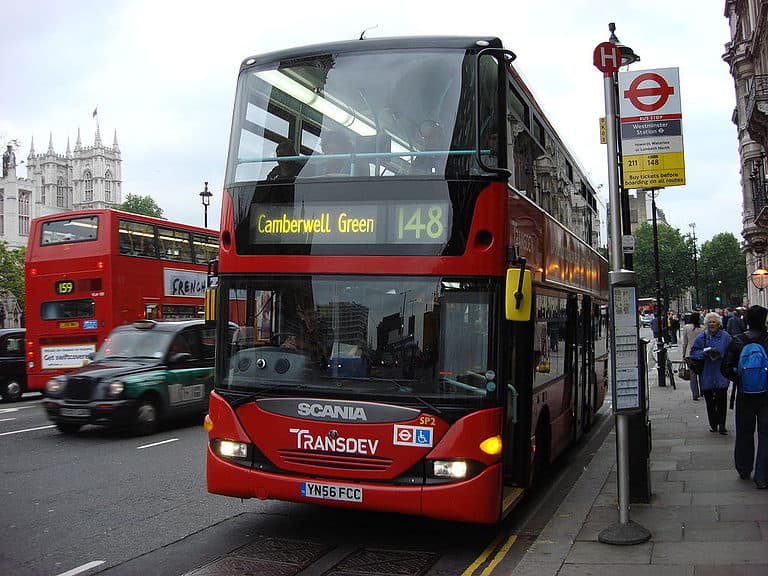
- Plan your trip ahead of time. It can’t hurt to check the timetables against the routes as not all buses run 24 hours a day. Look for an N on the routes that have night buses.
- When standing at a bus stop, look up at the sign above the stop. If it says “request stop” that tells you the bus will drive past unless you request that it stop . This is done by waving the bus down with your hand or a fare card. In fact, it can’t hurt to do this each time you see a bus that you want to get on.'This is done by waving the bus down with your hand or a fare card. In fact, it can’t hurt to do this each time you see a bus that you want to get on.
- Look at both the route number and the destination before boarding. Each stop may see a number of buses pulling up, so you’ll want to ensure you’re getting on the right one. This is where an app might be of help.
- Get on at the front of the bus and tap your card on the yellow card reader. You can depart the bus through the middle or back doors, but for the most part (and until all London buses are updated with card readers in the back) you’ll want to get in through the front.
- If you have multiple cards or devices for paying (for example, an iPhone and an Apple Watch) be sure to keep using the same one. Because of fare caps, you’ll want to ensure you’re not being overcharged if you swipe multiple times in a single day.
- Find your seat quickly. Bus drivers are in and out quickly, so if you’re not sitting, be sure to be holding on to a pole or handrail.
- If you’re traveling a route for sightseeing reasons, you may want to go up to the second level of the bus. The seats at the front of the second level give you the best view, making them popular. Just be sure to head downstairs quickly when you reach your stop (or even beforehand) because bus drivers will sometimes give you just seconds to get off.
- Avoid standing or sitting in the disability/pram (stroller) section at the front of the bus unless you need it. If you do, you will have to move if someone who needs it gets on.
- If buses are full, you can stand on the lower level. Just be sure to hold on to something.
- You’ll be able to follow the stops along the way on the digital signs inside the bus. There will also be an overhead announcement naming the stop. To get off at a certain stop, just before the bus reaches it, press the red stop button that you’ll see on poles around the bus.
- You don’t need to tap on your way out of buses or trams like you do on the Tube.
FUN FACTS ABOUT LONDON BUSES
Before you get down to the work of planning your bus trip, you might want to know a little bit about London buses.
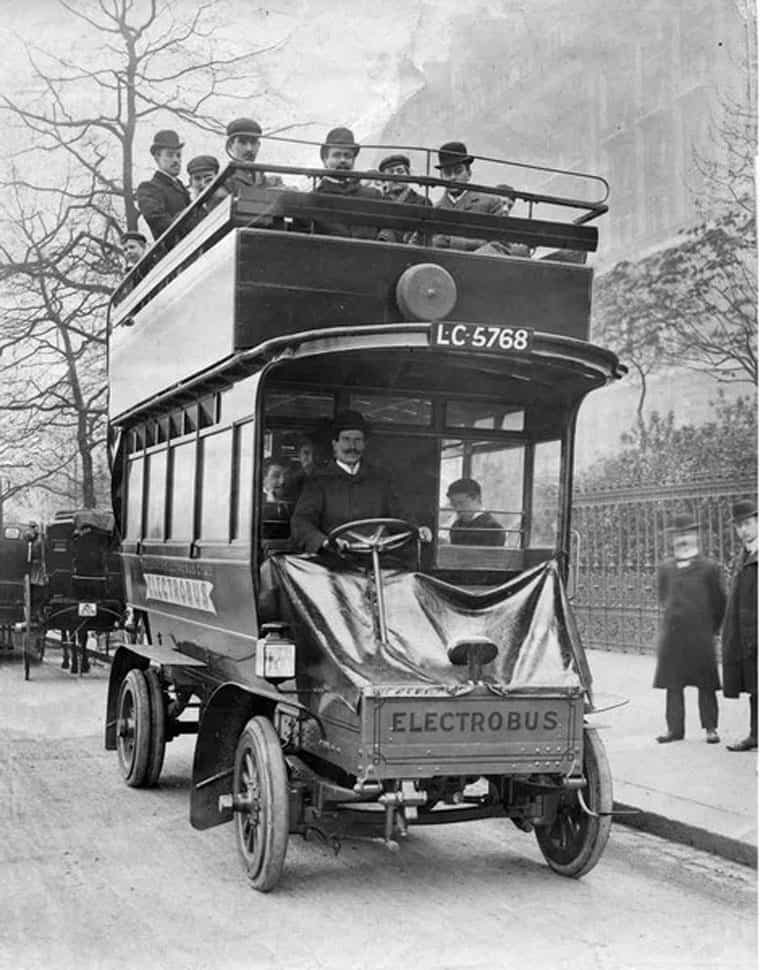
One of the most popular questions we get is:
Why are London buses red?
The very simple answer is that at one time, over 100 years ago, there were many companies with varying shades for their horse-drawn “buses”.
As many firms with differing schedules and rules were added to the city over the years, confusion reigned supreme.
In 1933 the London Passenger Transport Board (or London Transport) was formed in an attempt to bring all of the different companies together under one unified organization.
One of the companies, the London General Omnibus Company (est 1856) had a fleet of crimson buses, painted that way to make them stand out from others.
They were also the largest operator in the city so London Transport adopted their color scheme for all London buses.
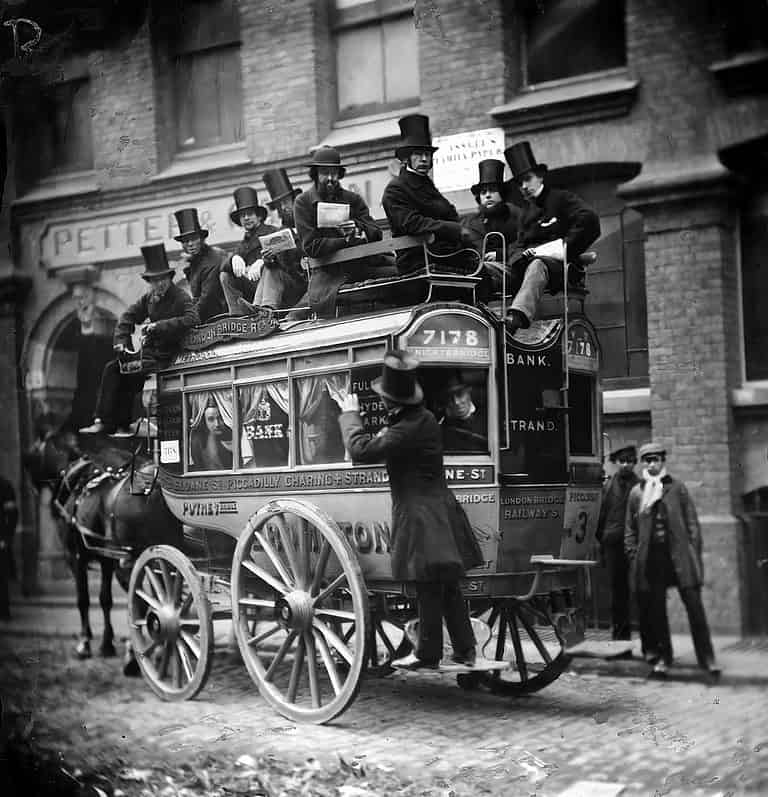
Another frequent question is :
Why are London buses double-decker ?
The answer to this is simple. There was a need for more space to transport people.
In fact, this goes back quite a long way, as the first double-decker bus was actually a two-level horse-drawn carriage!
By the 1920s, London started using the non-horse version of the double-decker bus we see today.
It remains a better fit for a city with tight streets, and one not often seen in other countries.
Today the red double-decker bus is a symbol of London, as well known to outsiders as the red telephone booth and black cab.
Choose a Destination... I want them all PLUS general travel tips. Amsterdam Berlin Boston Charleston Chicago Dubai Lisbon London Los Angeles Miami Nashville New York City New Orleans Paris Philadelphia Prague Rome San Francisco Washington DC
About The Author

North America
United kingdom & ireland, middle east & india, asia & oceania.
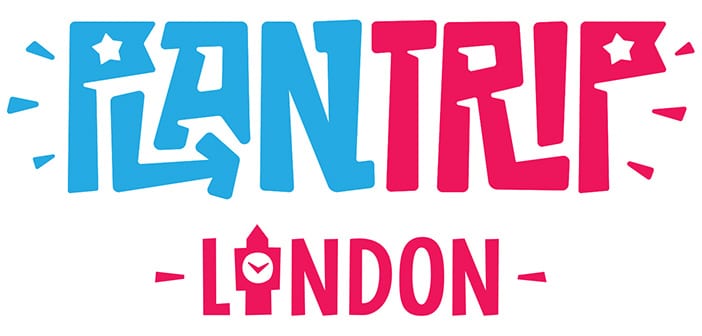
Oyster card or Travelcard in London: How to choose
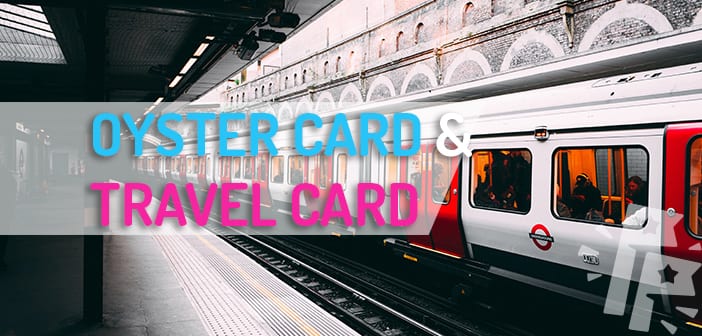
When planning a trip to London, you need to think houw you’re going to get around and what tickets you’ll need to pay for public transport.
Buying single tickets is simply not recommended, as it works much cheaper to use a transport card or contactless payment. The transport cards that you will need to look into are basically the oyster card and the travelcard. Using contactless payment works out exactly the same as using an oyster card.
However, deciding what works best for you can be a little daunting, so we will explain the main differences and hopefully help you make that decision.
London Oyster card, Travelcard or Contactless payment
One important thing to remember is that every person needs their own card. Unless you are just using buses, in which case, more than one person can use the same card. But for trains, underground, overground, trams, riverboat services or anything else you need one card per person.
London Oyster Card: What is it
The London Oyster Card is a pay-as-you-go plastic card, the size of a credit card. In order to get one you need to pay £7, and you can top it up as many times as you need and use it again and again. It’s valid for travel on the Underground, overground, DLR (docklands light rail), TFL rail, Emirates airline, and some trains. It’s also valid for travel within any of London’s Travel Zones , so you don’t need to choose what zones you will need it for when buying one. Every time you use it, the fare will be calculated depending on the travel zones that you have travelled to and from, and the time of the day you have made the journey (peak / off-peak).
It is the best option if you are visiting London and going to use London’s public transport a few times a day, for example, if you need to travel to get to central London from your hotel, then to get to a different place in London and then back to the hotel.
With an oyster card, you will pay for each journey you make, and there is a maximum daily cap. Once you have reached this daily cap, you will not get charged any more for extra journeys.
⇒ Read More about London Oyster Card
Contactless Payment on London Transport
This is slowly becoming the most popular option for paying for London’s public transport. Contactless payments work exactly the same as the oyster card, with exactly the same fares, and it saves you having to spend £7 on an Oyster Card.
A few things to have in mind if you are travelling to London from abroad are transaction fees and exchange rates. But in this case, you’ll find that nowadays, cards such as Revolut have made travelling much easier.
⇒ Read more about contactless payments on London Transport
London Travelcard
The London travelcard entitles you to unlimited travel for a set number of days within the London Travel Zones chosen.
This card that can be purchased for 1 day, 1 week, 1 month or 1 year, and with it, you have unlimited travel for the London transport zones you have chosen.
Generally speaking, a one-day London travelcard is something I don’t usually recommend as the oyster card’s daily cap is cheaper than the one day travelcard. A 7-day travelcard is helpful if you are going to use London’s public transport a lot (which doesn’t need to be the case if you plan your trip well), if you are going to be travelling outside of zones 1 – 4 every day or if you go are going to spend more than five days in London.
⇒ Read more about the London Travelcard
How to choose between Oyster Card, Contactless or Travelcard
To choose between an oyster card or travelcard to save as much money as possible when planning a trip to London, there are two things that we must take into account: The number of days that you are going to be in London and the travel zones that you are going to travel to and from:
Number of days
As a general rule, after comparing prices, I usually recommend a London Oyster Card or Contactless payment method if you are going to be in London for less than five days. If you are staying in London for more than 5 days, it’s probably worth getting a 7-day travelcard.
Travel zones
If you are buying a travelcard, you need to know what zones you’ll be using. London’s most popular attractions are mostly in zone 1. Some tourist attractions can be found in zone 2, such as Camden Town Market. But you also need to have in mind where your hotel is.
⇒ Read more about London Travel Zones
Oyster Card Daily Capping: Something to keep in mind when choosing between Oyster Card, Contactless or Travelcard
I must mention that the oyster card has a daily cap, and once this daily cap has been reached for certain travel zones, you can travel for free within the same travel zones. You still need to use your oyster card as you normally would, but you won’t be charged.
The cheapest one-day travelcard for costs £15.20. This is the price of the 1-day travel card for zone 1, zones 1-2, 1-3 and 1-4. The maximum daily cap when using an oyster in zones 1 and 2 of London is £8.10, £9.60 for zones 1-3 and £11.70 for zones 1-4. So, if you use an oyster card and travel in zones 1 and 2, once you have reached £8.10 you can travel free within zones 1 and 2.
2023 Fares Comparison: Daily Oyster Card Cap – 1 Day Travelcard – 7 Day Travelcard.
What’s cheaper according to number of days and travel zones, taking into account 2023 fares, what you should never do if you land at heathrow airport.
If you are thinking about buying a London travelcard for your stay in London if you are going to be in London for more than 5 days, and you arrive at Heathrow airport, we wouldn’t recommend that you buy a 7-day travelcard for zones 1 – 6 at Heathrow underground station to use during your whole stay as you will be paying too much.
I would recommend that you buy an oyster card at Heathrow underground station, and add a zone 1-4 travelcard onto it (if you are going to be in London more than 5 days), but use it with pay-as-you-go credit to get to central London on the first day and then again when you return to Heathrow airport.
Transport passes for children in London
Children under the age of 11 travel free within London travel zones. Children over 11 can also benefit from reduced fares; you can find out more about this in our article: Travelling in London with kids .
Find out more
For more information, visit London’s official transport website: Transport For London
Related Posts
London underground, london travel zones, travelling in london with kids, contactless payment on london transport.
What is your recommendation for buying a ticket for an 11 day stay in London (2 adults and children 16 and 13 years old). Hotel accommodation in Sutton with daily travel to and from the city centre, travel within zone 1-2 during the day + a day visit to the Harry Potter Studio. Thank you very much.
Hi Jan, Personally I wouldn’t recommend Sutton if you are going to travel to Central London every day as you would need to combine Underground with trains. We know some people that live near Sutton and most of the times the trains have delays or cancellations. The Harry Potter Studios are located in North London, while Sutton is in the South, so that day you would need around 2 hours to go there and another 2 hours to come back…
Also, depending on the airport that you would be arriving to, I would recommend a different area to find accommodation.
Hope it helps. If you have any questions about any other areas let us know.
Have a nice day!
Save my name, email, and website in this browser for the next time I comment.
Notify me via e-mail if anyone answers my comment.
Type above and press Enter to search. Press Esc to cancel.
Which is better: Oyster, contactless or travelcard?
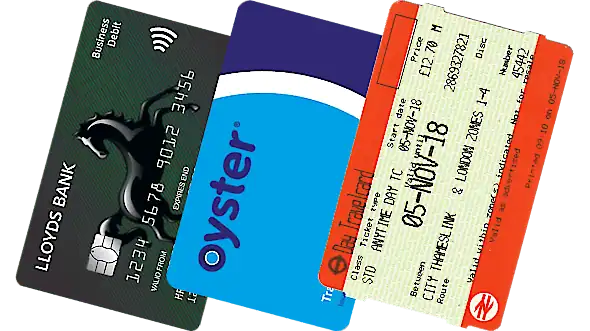
Which card should you choose?
One of the first decisions that a tourist has to make when travelling around London is whether to use an Oyster card , contactless card or travelcard .
The first thing to be aware of is that using cash to buy individual tickets is definitely the worst idea, as single tickets on the train are more than double the cost of Oyster and contactless, and you can’t even buy single tickets on the bus anyway. So which of the three cards do we recommend?

Oyster cards

An Oyster card is a credit card-sized piece of plastic. You load it up with money before you travel and then tap it down on the Oyster card readers on the buses and trains. The computer will then automatically deduct the correct fare from your credit. When you start running low on credit you can just top it up again at a ticket machine.
They come in two different types: normal blue Oyster cards are aimed primarily at the locals, whereas Visitor Oyster cards are aimed primarily at the tourists (although they are basically both the same, so it doesn’t really matter which one you get).
What are the benefits of using an Oyster card?
- The biggest benefit of using an Oyster card is its joint cheapest fares for single journeys (along with contactless)
- The Oyster daily cap is always cheaper than buying a 1-day travelcard
- Oyster pay-as-you-go credit can be used in zones 1-9, whereas travelcards are only valid in the zones you buy them for
- If you register your card online then you can turn on the ‘auto top-up’ feature which takes money out of your bank account whenever your credit gets low, so you don’t have to worry about running out
- Pay-as-you-go credit never expires, so you can carry on using any leftover credit on your next visit
- Visitor Oyster cards also come bundled with a book of discounts vouchers which can save you money at shops, restaurants and entertainment venues. These discounts are constantly changing all the time, but in the past they’ve included things like 10% off a boat ride, 10% off souvenirs in a particular gift shop, or 20% off a meal in a particular restaurant. The instructions for each venue will come with the vouchers, but most of the time all you have to do is show your Visitor Oyster card when you pay the bill, and the staff will apply the discount
What are the downsides of using an Oyster card?
- One of the downsides of using an Oyster card is that you can’t pay two fares with one card, so each traveller in your group will need their own
- The weekly cap only works from Monday to Sunday, whereas weekly travelcards can start on any day of the week you like
- You have to pay a £7 deposit whenever you buy a new Oyster card, or a £5 activation fee when you buy a Visitor Oyster card, which can’t be put towards fares
- You can’t buy a Visitor Oyster card in central London, only the normal blue Oyster cards. If you want a Visitor Oyster card then you have to buy it online in advance and have it posted to you
Contactless cards
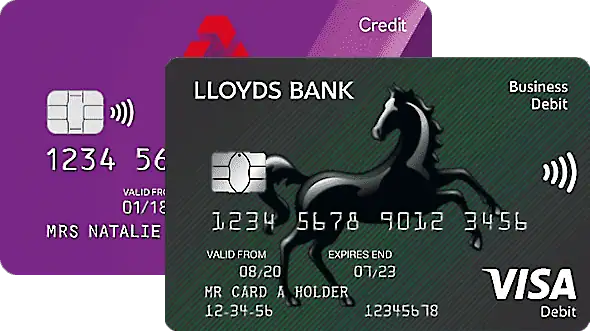
A contactless payment card is just your normal everyday debit or credit card. It works in exactly the same way as a London Oyster card . You just tap it down on the Oyster card readers on the buses and trains and the computer will automatically deduct the correct fare from your bank account.
What are the benefits of using a contactless card?
- One of the main benefits of using a contactless card is that it’s just your normal everyday bank card or credit card, so you probably already have one
- Contactless also has the joint cheapest fares for single journeys (along with Oyster)
- The contactless daily cap is always cheaper than buying a 1-day travelcard
- Contactless can be used in zones 1-9, whereas travelcards are only valid in the zones you buy them for
- Unlike Oyster cards, you don’t have to pay a £7 deposit to set it up
- Unlike Oyster cards, there’s no need to keep topping it up with credit because the money comes straight from your bank account
- Contactless cards can be used in conjunction with Mobile Pay on your phone
What are the downsides of using a contactless card?
- One of the downsides of using a contactless card is that you can’t pay two fares with just one card, so each traveller in your group will need their own
- Unlike with Oyster, you can’t load a travelcard onto a contactless card
- Not all foreign-issued cards are accepted, and foreign cards might have a transaction fee added on by your bank every time you buy a ticket, bumping up the price of your journey
Travelcards
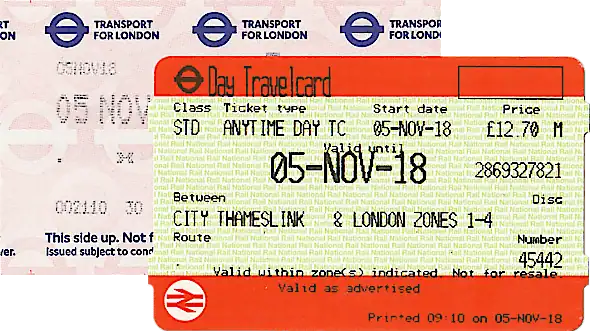
Travelcards are credit card-sized pieces of paper. They can also be loaded onto an Oyster card . You choose the duration you want it to cover (either 1-day, one week, one month or one year), whether you want it to cover just the bus/tram, or the train/bus/tram together, plus the zones you want to travel through, and then you’ll be entitled to unlimited travel in those zones until it expires.
What are the benefits of using a travelcard?
- The biggest benefit of using a travelcard is that you can make an unlimited number of journeys over one day, one week, one month or one year
- Depending on how many journeys you make in total, a weekly travelcard might work out cheaper than the Oyster and contactless weekly cap
- Unlike Oyster cards, you don’t have to pay a £7 deposit the first time you buy it
- You can take advantage of National Rail’s 2-for-1 offer to get cheap entry into 150+ tourist attractions. All you have to do is print out the relevant voucher from daysoutguide.co.uk/2for1-london and then hand it over at the attraction, alongside a valid National Rail travelcard for the same day of travel. But here’s the catch: the travelcard has to be printed on orange paper. That means that you have to buy it from a National Rail station (the big overground hubs like Euston , King’s Cross , Liverpool Street , Paddington , Victoria and Waterloo ). Travelcards bought at London Underground stations are no good, because they will be printed on TFL’s pink paper. And travelcards loaded onto an Oyster card are no good either
What are the downsides of using a travelcard?
- One of the downsides of using a travelcard is that you can’t share one between two people, so each person in your group will need their own
- One day travelcards are always more expensive than the daily cap on Oyster and contactless
- Unlike the pay-as-you-go-credit on Oyster and contactless cards, travelcards can only be used in the zones you bought it for. If you later decide that you want to travel outside of those zones then you’ll have to buy a completely separate ticket
- Travelcards are only valid for 1-day, one week, one month or one year – you can’t buy a travelcard that covers any other stretch of days
How do Oyster, contactless and travelcard fares compare?
Bear in mind that travelcards only allow you to travel between a set period (either one day, one week, one month or one year), whereas the Oyster daily cap and contactless daily cap apply all the time.
You can think of the daily cap as a price ceiling – it doesn’t matter how many buses or trains you ride each day, the maximum amount that the computer will take from your Oyster or contactless card will never rise above the cap.
Peak and off-peak fares – For Oyster and contactless peak fares apply to all journeys that start between 6:30 AM and 9.30 AM (Monday to Friday), or 4.30 PM and 7 PM (Monday to Friday). It doesn’t matter what time the journeys finish. Any other journey is classed as off-peak. Note: Between the 8th March and 31st May 2024 TFL are running a trial called ‘Off-Peak Friday Fares’, where Fridays will be classed as off-peak all day.
For travelcards, off-peak applies to any journey that starts after 9.30 AM (Monday to Friday).
Which is the cheapest: Oyster, contactless or travelcard?
The Oyster and contactless cap is always cheaper than buying a one day travelcard … but bear in mind that you also have to pay an £7 deposit on top the first time you buy an Oyster card , so a 1-day travelcard can still work out as better value.
The Oyster and contactless weekly cap is identical to buying a weekly travelcard, but you need to make enough journeys to make a weekly travelcard worthwhile. If you make at least three or more journeys on six days, or two or more journeys on seven days, then a 7 day travelcard will be worth it, otherwise you should go for an Oyster card or contactless instead.
Where can you use Oyster, contactless and travelcards?
Buses – Oyster cards, contactless cards and travelcards can be used on TFL buses all over London. And because buses don’t have zones you can use a train/bus/tram travelcard in whichever zone you like, regardless of which zones you actually bought it for.
London Underground, London Overground, DLR, TFL Rail, National Rail – The pay-as-you-go credit on Oyster cards and contactless can be used in all of the Oyster zones (1-9), but travelcards can only be used in the zones you bought it for.
You can also use Oyster and contactless on the Heathrow and Gatwick Express, but bear in mind that it won’t count towards the daily cap – it will just be deducted from your credit.
Taxis – Contactless cards can also be used to pay for black cabs (assuming that the fare is less than the current limit of £100). But Oyster cards and travelcards cannot.
IFS Cloud Cable Car & Thames Clipper – You can use Oyster cards and contactless to pay for a ticket on the cable car and Uber’s Thames Clipper service, but bear in mind that the cost will not count towards the daily cap – it will just deduct the relevant fare from your credit. Travelcards cannot be used to pay the fare.
How long do Oyster, contactless and travelcards last?
The pay-as-you-go credit on an Oyster card lasts forever. If you don’t use all the money up during your first holiday then you can simply carry on using it during your next visit.
Contactless cards don’t expire either, because they take the money straight out of your bank account.
A travelcard is the only one with an actual expiry date, because you have to choose a start date and duration when you buy it – either one day, one week, one month or one year. Once the duration has passed then the travelcard will stop working.
Which is best: Oyster, contactless or travelcard?
So which is better? If you’re a foreign visitor coming to London for just one day then we recommend choosing a one day travelcard . The Oyster and contactless daily cap might seem cheaper, but when you factor in the Oyster card’s £7 deposit, and the fact that your bank might add on a transaction fee every time you use a foreign bank card overseas, then a travelcard will likely work out cheaper.
If you’re a foreign visitor coming to London for more than one day then we recommend buying an Oyster card or Visitor Oyster card instead… unless you’re planning on making two or more journeys on seven consecutive days, or three or more journeys on six of those days, in which case a weekly travelcard will work out cheaper.
If you’re a UK visitor then we always recommend using your contactless card , regardless of how many days you’re staying, because the fares are the same as Oyster and you don’t have to pay a deposit to get one.
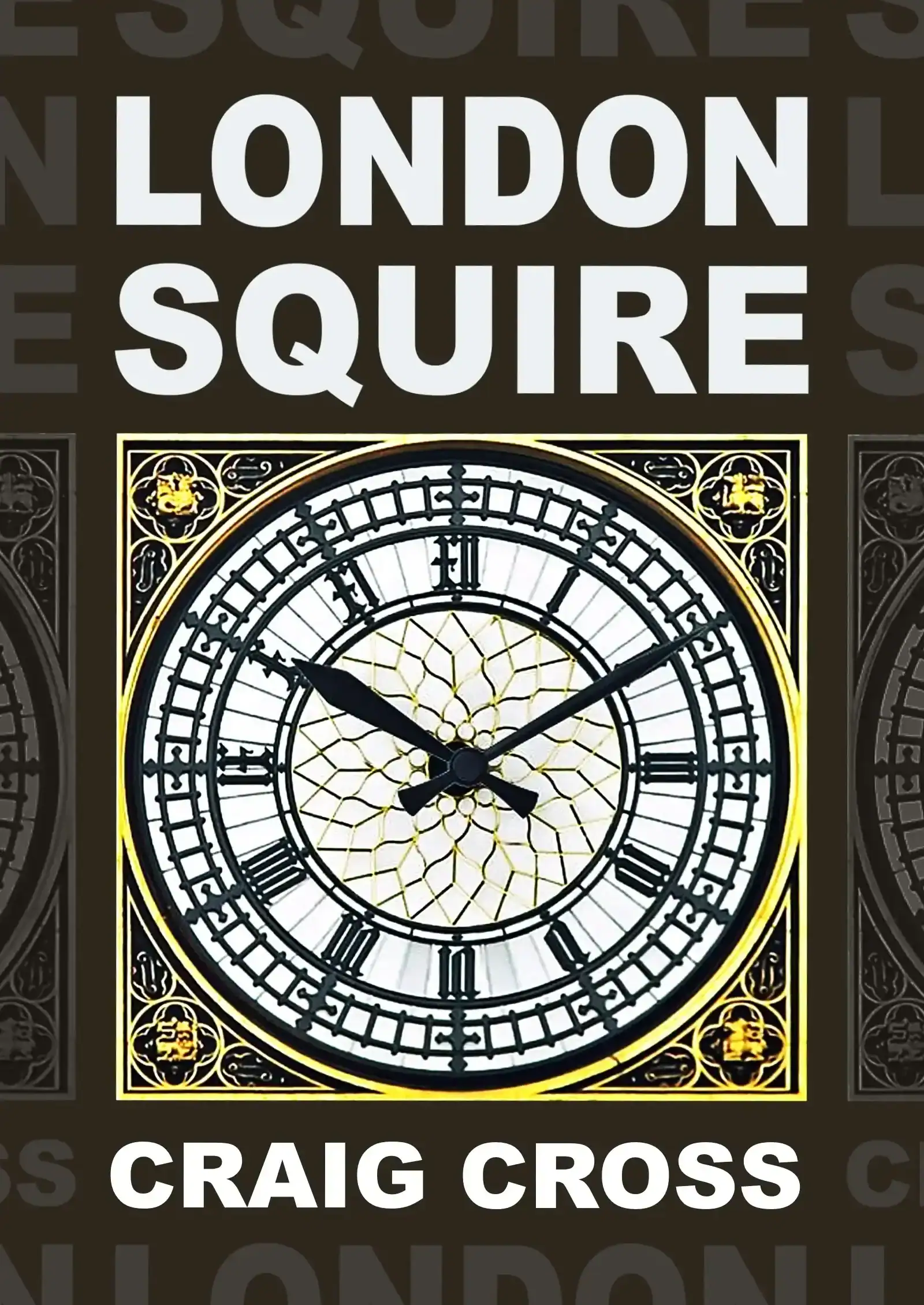
Your comments and questions
Jane Is a two traveling together card, work out cheaper than a pay as go Oyster card
Staff Hi Jane. No, if you're talking about the railcard then it doesn't apply to Oyster pay-as-you-go fares. It's only really any good if you're travelling on trains outside of London - twotogether-railcard.co.uk/using-your-railcard/travel-times-tickets/
JohnP My sister and I are coming to London for a week of museums and galleries. We've been there three times before, but each time I get confused between travelcards, Oyster cards, etc. We arrive and depart through Heathrow, and we're staying near Holland Park/Kensington, so I THINK the 7 Day travelcard is what we should use, but I'm not sure. Any suggestions or help in explaining it more clearly would be greatly appreciated
Staff Hi JohnP. Weekly travelcards always have a start date on them (which you choose when you buy it) and they're valid for for seven consecutive days. You also have to choose which zones you want it to cover. You'll probably want zones 1-2, but it depends where you're going. Oyster cards 'might' be better because they don't have a date on them, they can be used in all the zones, and they cap the maximum price you can spend each day (regardless of how many journeys you take). You can look up the daily caps on our Oyster card page - city-guide.london/transport/oyster-cards.php . This might work out cheaper, but if you're making at least three or more journeys on six days, or two or more journeys on seven days, then a weekly travelcard will be better
Tony Hi. I'm London travelling across zone 1 and 2 for 3 days. Is it right that if I use a contactless card the cap will allow me to travel off-peak for less than a one day travelcard
Staff Hi Tony, that's right. The daily cap for zones 1-2 is only about half the cost of a 1-day travelcard
Bobbie I'll be in England for a month with several train trips. I just purchased a Senior Railcard. Can I get discounted fares on the tube? And how do I use it in conjunction with contactless credit card payment?
Staff Hi Bobbie. Most of the savings come from buying National Rail tickets, The only discounts you get on the tube are 33% off the daily cap for Oyster fares (off-peak only), 33% off single Oyster fares (off-peak only), and 33% off a zone 1-9 one day travelcard (when bought as part of a journey to London from outside London). You have to buy an Oyster card and get the Senior railcard loaded on to it. It doesnt work with contactless because its not possible to load the railcard onto your bank card - senior-railcard.co.uk/using-your-railcard/travel-times-tickets/
Susan Tchudi We're coming to London for ten days. We're staying in Kensington. We've always used travelcards in the past, but we'll probably want to go beyond zones 1 and 2, for example to Kew Gardens. So would it be better to get the Oyster card?
Staff Hi Susan. If youre staying for ten days then it will be cheaper with an oyster card, because you can only buy 1-day and 7-day travelcards. the maximum you'll pay with Oyster is the weekly cap x 1 (which is the same price as a weekly travelcard) plus a daily cap x 3 (which are cheaper than a 1-day travelcard) for whichever zones you travel through. all the caps are here: city-guide.london/transport/oyster-cards.php
JennyJ Hi, I am JennyJ. I go betwenn zone 1&3, there and back 3 times a week and also twice a week to zone 5 (hayes& harlington). I use an Oyster card and top up 20.00 as and when its low. What is the cap for this journey each weekplease. Is it £9 or £11 or neither. I dont know how to work out but dont think I am better off buying a card to cover zones 1-5 as only go max twice a week.
Staff Hi Jenny. The daily cap for the days when you're doing zones 1-3 is £9, and when you're doing zones 1-5 it’s £13,10. a weekly travelcard for zones 1-5 is currently £65,70, so its not worth it - city-guide.london/transport/adult-train-fares.php
Wangui Going through this information has been super helpful, thanks so much! My family of 4 foreigners are coming to London for 11 days from Heathrow Airport and staying at a location in Zone 6, are likely to be visiting attractions in Zone 1 everyday but also traveling to Surrey on 2 days. What is the cheapest means of travel payment to use? -VOC or travel card considering the £7 deposit and postage fee to a UK address for VOC? -If VOC then how much credit should be loaded on the cards? -Also is the weekly/daily cap applied to VOC automatic or how does it work; do the particular days eg Monday, Tuesday, Wednesday need to be specified?
Staff Hi Wangui. If it was me I would probably just keep it simple and get Visitor Oyster cards for everyone, and forget about the travelcards. Visitor Oyster cards have a weekly cap which is the same cost as a weekly travelcard anyway, so you wont be losing anything (apart from the £7 deposit - which you'd have to pay anyway because you'll need something to cover the other four days). How much credit you need will depend on where you’re going. The maximum amount you will pay each day is the ‘daily cap’ for the zones you travel through. The daily cap for zones 1-6, for example, is currently £14,10 - but maybe you’ll only be making 2 journeys each day, going there and back, so then you’d just pay two single fares instead - 2x£5,50 . If the running total between Mon-Sun reaches the weekly cap then the cost will be capped at that (currently £70,30). The caps all get applied automatically. Its all explained on our Oyster card page - city-guide.london/transport/oyster-cards.php
jan Hi, I am currently travelling to work from slough to zone 3, (i would also sometimes go to the other zones (1-6) - by bus/underground after work. I am using the contactless method. The job is Monday to Friday, I wanted to know if buying a weekly/ monthly travelcard would work out cheaper as I also have a 16-25 railcard. Also how does the weekly cap work? does it add your daily charges and refund you if you go over the cap?
Staff Hi Jan. Travelcards usually work out cheaper if you’re making two or more journeys on seven days a week, or three or more journeys on six days a week. You wont get it cheaper with for your railcard either, because it only gives a discount on 1-day travelcards for zones 1-9. I would recommend getting an oyster card instead because the fares and weekly cap are identical to contactless, but you can have your railcard added to it. You can’t do that with contactless. But check the travel times apply to you first, because they might not - 16-25railcard.co.uk/using-your-railcard/travel-times-tickets/ . The weekly cap will kick in when the sum total of all your journeys that week reaches the relevant amount (its the same price as a weekly travelcard). The computer will then automatically stop charging you. Bear in mind that it only counts up the fares between Mon and Sun, and not any other combination of days, like Tue to Mon
frankie Hi, I would like to ask, if you use the same contactless card but one day you use it as the actual physical card and then the next day you use your mobile phone to pay (but with the same debit card) would it count towards the weekly cap?
Staff Hi Frankie. Unfortunately not, no. The computer wouldn't recognise it as the same card because things like Apple Pay don't pass over your card number (it passes over a unique number based on your bank card and device instead). TFL says “Always use the same device or contactless card to touch in and out… For example, don't touch in with an iPhone and touch out with an Apple Watch or contactless card” - tfl.gov.uk/fares/how-to-pay-and-where-to-buy-tickets-and-oyster/pay-as-you-go/contactless-and-mobile-pay-as-you-go
Betty Hi I will be in London for a week. I will be staying at a hotel at the Heathrow airport and going back and forth between there and the actual city of London. Is the Travel card best and what zones would I pick? Thank you
Staff Hi Betty. it depends how many journeys you're going to be making. If you make two or more journeys on seven days, or three or more on six days, then a weekly travelcard will probably be cheaper. We’d normally recommend getting an oyster card. All the pros and cons are described above. Heathrow to central London is zones 1-6.
Canan Hi, I'll be visiting London this summer. My daughter is 10 years old (born in 2013). Is she going to be free of charge or discounted?
Staff Hi Canan. Under 11s are free on the buses and tube (as long as she’s accompanied by an adult on the tube) - city-guide.london/transport/child-train-fares.php
Cristina Grilo Amaral Hi, we are a family of 4 and will be in London for 6 days. We will be riding transport a lot on those days, in zones 1- 2; meaning we should make about 6 tube trips a day. We will arrive and depart via Heathrow so we have 2 journeys (1 outbound, 1 return). Can you please indicate which card you recommend? Thank you so much.
Staff Hi cristina. Price-wise, the best would be a zone 1-2 weekly travelcard put onto an oyster card, and then adding some pay-as-you-go credit onto the same oyster card to cover the two journeys out to heathrow zone 6. But if you want to keep it easy and dont mind paying a bit more, then just get zone 1-6 weekly travelcards instead
Elaine I am travelling with a 14 year old and I would use contactless for myself but what would be the best option for my 14 year old.
Staff Hi elaine. It depends on how many journeys you're making. If you're just talking about one day, there and back, then i would buy her single tickets at the self-service machine (using your card), and then use your card on the gate for yourself. So she will end up paying the adult cash fare, and you’ll get the adult contactless fare.
Mike M We are arriving in London in late May for 3 days and another 4 days in early June after travelling around UK on Britrail Pass. While in London what would be the best card to use on Underground and 1 day to Watford
Staff Hi Mike. I would get an oyster card. there are no dates on those, so you can carry on using your credit when you return in june. You can also use them out to Watford (assuming you’re going to see the Harry Potter studios)
Ali Hi, we are a family of 4 travelling to London over Easter from the UK. We have a friends and family railcard, and I'm just wondering what is the best way for us to travel around, given we will be sightseeing in London for a few days, and also travelling to Paris via Eurostar. We also will be visiting London again in the summer for a few days. It is myself, my partner and 2 kids (ages 7 and 14). Am I right in thinking contactless is best for 3 of us (and doesn't my 7 year old travel free?). Or should I sort getting an oyster cards for us instead? Thank you for your advice in advance. Cheers Ali
Staff Hi Ali. Contactless will be the cheapest for the two adults. Your 14-year-old can't use contactless if they don't have their own bank card (the system doesn't allow you to tap your card down twice to pay two fares), so I would get the 14-year-old an Oyster card and then have the 'Young Visitor Discount' applied to it once you arrive in London - more info about that here - city-guide.london/transport/child-train-fares.php . The 7-year-old will travel for free.
Ali Thank you so much for that perfect and swift response. Amazing!
Sue Can we pay contactless for ourselves and our grandchildren?
Staff Hi Sue. No, each person needs their own bank card. The system doesn't allow you to tap down multiple times to pay multiple fares. What you can do is use your card to buy them a paper ticket at the machine (which will be charged as a cash fare) and then tap down on the gate for yourself (for a contactless fare)
Sue We are coming to London for one day with two grandchildren 12 and 25 years old. If we use our debit contact less card for us can the grandchildren use our credit contactless card? Although we know that would be a full fare.
Staff Hi Sue. If you mean you want to use one debit card to pay two contactless fares, and one credit card to pay two contactless fares, then no. The system doesn't let you tap down twice to pay two fares. Each individual needs their own card. But you can use one card to buy more than one paper ticket from the machine. But then you'll be paying the cash fare.
Hiko Hi,I’d like to know about 7day travel card. I’m plannning to go to Birmingham,Brighton,Wembley,and sightseeing inside zone1-2.(My son loves soccer!) My hotel is in zone1.I will stay there about 8days. If I buy 7day travel card with zone1-2,how can I go outside of that zone? Can I ride the national rail with my travel card such far area?? Does the card pay the difference, when I go outside of the zone2,like Wembley zone4?
Staff Hi Hiko. I would buy yourself an Oyster card and have the travelcard loaded on to that (rather than getting a paper travelcard). Then you can load some extra pay-as-you-go credit onto the same Oyster card to cover the extra fares. You can ride National Rail trains with a zone 1-2 travelcard, but only in zones 1-2. If your journey goes further than that then the computer will recognise that the travelcard covers 1-2, and automatically take the extra money from your pay-as-you-go credit. But places like Birmingham and Brighton are too far away for travelcards and Oyster. You will have to buy totally separate tickets for those.
Siegrid I want to go by train from city airport London to St. Pancras and may pay cash. Is there a chance for paying?
Staff Hi Siegrid. Not sure what you mean by ‘chance’, but you can pay cash at some of the self-service machines, Some will accept cards only, and some cards and cash. it will say which at the top
Peter I have a 7 hour layover at Heathrow and wish to go into Covent Garden for the day. Which is the best option for me to travel into London.
Staff Hi Peter. If that's the only place you're going then I would just buy a single ticket at the machine (zone 1-6). You can choose a return journey and it will give you two single tickets. It's not worth getting an Oyster card or travelcard just for there and back.
Julia Dear all, we a family of two adults and one 12 year old want to spent Saturday and Sunday in London. We would only need zone 1 tickets. We arrive at Gatwick and already organized this transfer by bus because of the train stikes this weeekend. Would You recommend the visitors Oyster or just day travelcards for us?
Staff Hi Julia. If it's just one day then I would probably go for a travelcard, which is easier (they sell cheaper ones just for the bus, if that's what you're planning on doing). The fares with a Visitor Oyster Card are cheaper, but they make you pay an extra £5 activation fee on top the first time you buy one, which would wipe out any savings. But if you think you'll come back to London another time then it would be worth getting Visitor Oyster cards, because you can carry on using the same ones then.
Mike Is a monthly travel card valid for a calander month or 28 days
Staff Hi Mike. It lasts until the previous date the next month. So if you choose a starting date of 20th February it will end on 19th March. If you choose 10th December it will end on 9th January. So it could be a different number of days.
Marcella Am coming to London for two nights with husband, sister and brother in law who has dementia. Will be making trip from Stansted airport to Deptford and home again via Gatwick and staying mostly around Greenwich area. We can use contactless cards but my brother in law can’t really do any cards himself and we can’t use ours to put him through the barrier? Do we just get him a ticket? Are their staff available to help if need be Thanks
Staff Hi Marcella. Its not possible to pay two fares with one contactless card (it doesnt deduct two fares if you tap it down twice). Maybe the best thing to do is get him an oyster card with some credit on it, but tap it down on the gate yourself and send him through the barrier, then just follow straight behind him after youve tapped your contactless card down. It would only take a few seconds to get you both through. Or you could ask a member of staff to help. You can usually find them standing behind the extra wide barrier they always have for wheelchairs and buggies.
Cheryl Stefanik We live in the state of Washington (zip code 98198). What is the charge/fee to order an Oyster card vs. the charge/fee to get a Visitor's Oyster card? Is the only difference in function that we cannot add money to the Visitor's Oyster card online?
Staff Hi Cheryl. there's no way to order an Oyster card online and have it posted overseas. You can only do that with Visitor Oyster cards. If you want a normal Oyster card you'll have to buy it when you arrive in London. There are a few more minor differences. You can't load travelcards onto visitor oyster cards (but you probably wouldn't want to do that anyway). And visitor oysters come with their credit already added, whereas normal oysters will have it loaded on when you buy it. Visitor oysters also have a non-refundable £5 deposit, whereas normal oysters have a non-refundable deposit of £7. The full list of differences can be found here - city-guide.london/transport/visitor-oyster-cards.php
Gordon Jamieson If your journey requires 2 tubes how does contactless work?
Staff Hi Gordon. You tap down at the start of your journey, and again at the end. You don't have to tap down for the station in the middle because you shouldn't have to pass through any barriers when changing platforms. (If you did happen to pass through a barrier then that would be the end of the journey)
Alex A Family of 5 travelling to London in early October. 2 adults, 2 children between 11-15 years, and 1 child who is 9 yo. Which ticket/card should we opt for as the youngest child travels free (I think) and the other 2 children get discounted fares. Can we arrange for a discounted fare oyster card when we arrive in London or do I need to arrange this from Australia before I leave? Or is there a travel card that can be bought for ‘students’? We will spend most of the time in Zone 1/2 but need to go to Watford for the Harry Potter Studios one day. PS we are arriving in London on the Eurostar as I heard you could buy oyster or visitor oyster cards on the train. Thanks, Alex
Staff Hi Alex. You can get Visitor Oyster cards posted to you overseas, buy them on Eurostar, or buy a normal Oyster card when you arrive in London. i would get either of those for everyone (apart from the 9 year old), and then have the ‘Young Visitor Discount’ applied to the kids cards when you’re in London. Its not possible to do that beforehand. it’s explained on this page - city-guide.london/transport/visitor-oyster-cards.php
Carol Two of us are headed to London for 14 days, most of that staying in Fulham. We are def there to sightsee in all directions. I want the card that's best for use on all forms of transportation including the Thames Clipper. Help!
Staff Hi carol. If you have a UK bank card then I would just use that, and pay contactless fares. Otherwise you should get an Oyster card - city-guide.london/transport/contactless-cards.php
HFPOM Hi, me and my wife are staying for 3 months in London, and we will be going from city center to Stanmore. What would be the best option? Thank you
Staff Hi Hfpom. There are pros and cons to all of them, which we’ve described on this page. But you’ll probably find that you’re better off with an Oyster card. If you have a UK bank card then might want to use contactless instead.
Chris Borland Hi, my and and I are coming to London for a long weekend, (Fri-Mon) what do you recommend we use for getting about seeing the sights?
Staff Hi Chris. It depends whether you're from the UK or abroad. Like we say above, if you have a UK bank card then the cheapest fares are with your contactless card. If you have a foreign bank card then you should go with Oyster in case your bank adds on a transaction fee every time you use it overseas
You must enable javascript to leave a comment
> Forum: London Buses, Taxis & Trains
RELATED LINKS
On this page, fare zone maps (pdf), public transport london, fares & payments, london airport transfers, cruise port transfers, travel to / from london, most popular tours.

- Guide to hotel areas
- Bed & breakfast
- Backpacker hostels
- Airbnb London
- Central London tours
- Tours from London
- Hop-on hop-off bus tours
- Harry Potter tours
- Stonehenge tours
- Downton Abbey tours
- Windsor tours
- Cotswolds tours
- Private tours
- Ticket & pass offers
- Central London attractions
- Attractions outside London
- Harry Potter attractions
- Tower of London
- PUBLIC TRANSPORT
- London City
- London Southend
- Southampton
Best London transport pass - Oyster, Travelcard or Contactless
Make an informed choice on the right london travel pass for you with question and answer blog if needed.
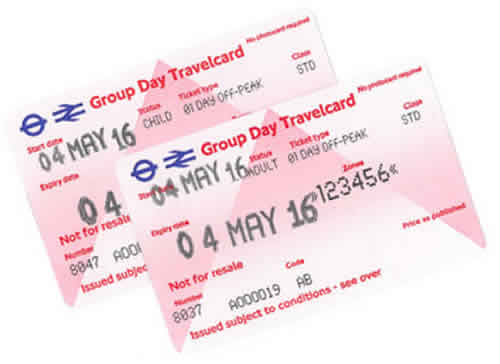
If you want the best public transport deal for your visit to London there is no doubt that at first sight the various ticketing options are bewildering. There is no universal best option, each option has its own market.
Invest just a little time into understanding the options and by picking the right solution for you. As well as saving significant money you will also save time and have a stress-free experience.
We have a dedicated detailed analysis page explaining in detail the differences between the various ticketing options (see link below). This page is a more simplified step by step approach to identifying the best public transport pass for you in London.
Oyster, Travelcard or Contactless - detailed comparison of your ticketing options
After reading both pages if you are still confused then you can Ask Bob at the foot of this page, where you can discuss your particular situation.
Select the right pass Contactless cards Visitor Oyster & Oyster Frequently asked questions Still confused? Ask Bob

Selecting the right transport pass for you
For the tourist or those making short visits to London there are aspects of the Travelcard that make them very appealing and if understood can make Travelcards cheaper than Oyster cards or contactless payment cards, especially if you are visiting the major sights on a first-time visit.
So all in all it can be quite confusing for the visitor planning their visit to London to make an informed choice.
This page discusses the differences between Oyster, Contactless Payment Cards and Travelcards so you can identify the right product for you, our detailed Travelcard , Contactless Payment Cards and Oyster card pages give a full explanation of each.
Contactless Payment Cards - on paper best for many but with major drawbacks
Contactless payment cards have become mainstream for payment of public transport in London. In the long term this type of technology may well become dominant, replacing Oyster as the most popular payment method.
The big attraction of contactless payment is you can use your own credit/debit card or even your mobile phone linked to an Apple Pay account with no need to purchase any dedicated transport ticket.
Contactless payment uses Oyster fares, the lowest fares unless you are staying more than five days.
The main reasons why visitors do not use contactless payment:
- If you are from overseas your fares will converted from pounds sterling to your local currency daily by your provider, often with significant foreign exchange charges.
- Each person needs their own contactless supported credit/debit card or mobile phone account, you cannot share.
- If you are staying and travelling in London for more than 5 days in any 7, a 7 day Travelcard is cheaper than Oyster fares.
- Concessionary fares (including children) are not supported by contactless payment.
Contactless Payment - full details
Visitor Oyster cards & Oyster cards
Oyster fares are the lowest fares and if you are not using contactless payment then you need to buy an Oyster card to gain access to the Oyster fares.
For most overseas visitors an Oyster card or a Visitor Oyster card is the most popular ticketing solution.
A lot of visitors are under the impression that a Visitor Oyster card is in some way a better deal than a standard Oyster card purchased in London, but on balance the reverse is true.
The only reason to purchase a Visitor Oyster card is if you are happy to pay a price premium for a less flexible product just for the convenience of having the Oyster cards in your hands before departure to London.
Oyster cards bought in London have a refundable deposit of £5, Visitor Oyster cards have a non refundable deposit of £5.
Oyster cards bought in London allow you to load Travelcards (but not 1 day Travelcards) onto your Oyster. If you are staying 6 or more days a 7 day Travelcard will probably be cheaper than Oyster alone. Visitor Oyster cards do not have this capability.
Oyster cards - full details
Do you have any children under 18 years?
If yes, read the article linked below about obtaining half price or free child fares before you go any further and factor this into your Oyster v Travelcard decision. (Contactless payment cards are not an option for concessionary fares like children).
I’m afraid child fares are really complex so it is worth taking some time to understand the options available.
Child fares on London Transport - full details
In London 5 or more days? (Combining Travelcards and Oyster)
If you are travelling 3 or more times a day for 5 or more days in any 7 day period then a 7 day Travelcard becomes cheaper than an Oyster card.
If you are staying in London for say 10 days or are staying in the outer zones where your travel patterns may well be more irregular in terms of which travel zones you travel through, it may well suit you to combine Oyster and Travelcard, sometimes using both for the same journey.
For Oyster cards bought in London (but not Visitor Oyster cards) you can load 7 day, monthly or annual Travelcards onto the Oyster card. You cannot load Travelcards onto contactless payment cards.
So, if you have an Oyster Card with money loaded onto it under Pay As You Go and a 7 day Travelcard zone 1/2 loaded onto the same Oyster Card, a classic example of where it becomes beneficial to the visitor is outlined below:
You are flying into Heathrow (Zone 6) and staying in a hotel in Central London (Zone 1) and sightseeing for 9 days before flying out of Heathrow. One day you are visiting Hampton Court in Zone 5.
What you can do is buy an Oyster card at Heathrow Airport Underground Station and load some money onto it immediately and use it as an Oyster card. On the third day you buy a 7 day Travelcard zone 1 and 2 and load that onto the Oyster card.
For the next 7 days all your travelling is in the central zones except the airport trip on the last day and your trip to Hampton Court. On 5 of the days where you are exclusively travelling in zones 1 and 2 the Travelcard covers all of your travel needs.
On the journeys to and from Hampton Court and to Heathrow the system will take from your Oyster an extension fee to cover the part of the journey outside zones 1 and 2 covered by your Travelcard. This is performed automatically with no input on your part.
1-day Travelcard cannot be loaded onto Oyster Cards
If you buy Travelcards only and for a duration of 7 days upwards, unless you buy from a national railways ticket office in London or online from an overseas agent, your Travelcard will come loaded on an Oyster Card. If your Travelcard is purchased from a railways ticket office or online in advance it comes in the format of a card ticket with a magnetic strip, not on an Oyster.
Travelcards - full details
Is sightseeing a major part of your visit to London?
If you are visiting places like the Tower of London, Madame Tussauds etc there is a railways promotion that is available to people with Travelcards purchased from the railways that is not available to Oyster card holders.
Under the promotion one person pays the full adult admission, the other goes in free. For places like the Tower of London that’s a saving of over £20 – savings can easily be more than the cost of the fares that day!
The savings are substantial, and you have to jump through a few hoops, but many end up buying Travelcards purely on the basis of obtaining these savings on your sightseeing, even though an Oyster card would be cheaper for the transport alone.
Railways 2 for 1 sightseeing promotion - full details
Are you travelling in a group of 10 or more?
If you are travelling in a group of 10 or more a 1 Day Group Travelcard may be cheaper than either Travelcard or Oyster card, but only if you travel outside zones 1 to 3.
This is the only group fare available. There are no family fares or passes either for smaller groups.
1 Day Group Travelcard - full details
Travelling to and from London's airports
Heathrow airport.
Heathrow Airport is in Zone 6 of London’s transport system. You cannot use Oyster or Travelcards on the Heathrow Express trains to/from Heathrow, but you can use them on the Underground, TFL Rail Heathrow and London buses at Heathrow.
Do not get a 7 Day Travelcard for zones 1 to 6 just to cover the Underground transfers from Heathrow. Get a 7 Day Travelcard zone 1 to 2 loaded onto an Oyster to cover the airport trips, you will save a lot of money this way. (See example in the “In London 5 or More Days” section above)
City Airport
City Airport is in Zone 3 of London’s transport system and is served by the DLR system that connects with the London Underground.
Gatwick Airport
You can use Oyster pay as you go and contactless cards on train services between London and Gatwick Airport, but you cannot use Travelcards.
Whether it's a good idea to use Oyster rather than buy tickets from the railways is another question and a complex one to answer. You will need to carefully read our dedicated pages on the Gatwick trains and understand how Oyster works to make an informed comparison.
Gatwick - London trains - full details
Luton, Southend & Stansted Airports
Neither Oyster or Travelcard go out to any of these airports, so your airport transfers are a separate purchase to your London transport.
Just making 1 or 2 journeys?
You cannot pay cash and buy a single ticket on the buses. On the trains and underground you can buy a single ticket but it comes at a punitive price for most journeys compared to Oyster.
If you have a credit/debit card that supports contactless payment then use it, this will be your cheapest fare, though if you are from overseas your provider may have foreign exchange charges. Oyster Cards have the same fare structure as contactless payment cards.
If you have neither Oyster or contactless payment card then you have an awkward decision. You can pay single cash fares on the underground and trains, but not buses. For most journeys you will pay a significant price premium over Oyster fares.
You can get an Oyster card. This ensures you have the cheapest fares but you have the hassle of the Oyster deposit on purchase then cancelling your Oyster at the end of your trip to reclaim your deposit and any balance left on the card.
Still confused, got something you want to add? Ask Bob!
If your requirement is complex or not neatly addressed by the above just make a comment or ask a question below. Normally, Bob, our resident expert and author of this page will reply within 24 hours.


Avoid These Tourist Traps In London And Visit These Destinations Instead
O ne of the world's greatest cities, London is packed with tourist attractions so impressive that you'll want to add them all to your itinerary. From the Tower of London to Buckingham Palace to the Churchill War Rooms, the list of unmissable landmarks seems endless. Don't worry, though -- it's possible to visit most of them in just a two-day trip . When you're on a tight schedule, it's important to avoid time- and money-wasting tourist traps in favor of visiting sites that are worthy of your attention.
Whether it's an overrated and overpriced wax museum, a kitschy dungeon experience, or a super crowded viewpoint, there are many places to avoid visiting in the U.K.'s heady capital. The confusing part? Some of them top multiple lists of must-see attractions. That's where we come in.
As someone who lived in this captivating English city for six years, I have first-hand knowledge of the biggest tourist traps to avoid when traveling to London. Plus, I can offer more impressive (and often less costly) destinations to visit instead. Don't want to take my word for it? No problem. I combined my first-hand knowledge with reviews and suggestions from other locals to create this list.
Read more: 50 Underrated Tourist Destinations Around The World
Skip Hop-On Hop-Off Bus Tours And Ride A London Bus
While hop-on hop-off bus tours can be a convenient way to explore a big city, they often come with a hefty price tag. If the tour is based in London, you can expect to pay over $50 per adult for a one-day pass. Instead, board a London bus, which will cost less than $7 for a day of travel. Bus fare for one ride is about $2 and the daily cap is under $7. To pay for their ride, visitors must use a contactless card or an Oyster Card, the visitor's version of which can be purchased online and mailed to your home before you leave.
Double-decker London buses offer spectacular city views, with many routes passing right by London's landmark attractions. One of our faves is the historic Routemaster Bus 15, which we suggest boarding at the Tower of London. Hop on at Great Tower Street (Stop TT) and ride west to Charing Cross Station. Be sure to sit up top for the best views along this heritage route -– you can't miss St. Paul's Cathedral and Trafalgar Square.
Bus 24 is another great option for sightseers. Hop on at Victoria Station and ride it to Camden High Street. Along the way, you'll pass Westminster Abbey, the Horse Guard's Parade, Trafalgar Square, and Downing Street. Grab a bite at Camden Market when you disembark or stay on until you reach Hampstead Heath where you can catch unbeatable views of the city.
Skip Madame Tussauds And Visit Buckingham Palace
It may tout itself as a top London attraction, but Madame Tussauds would be more honest if they said they were the top rip-off site. Booking in advance will save some money -- the standard online rate for an adult begins at just over $47 versus the walk-up price, which begins at almost $60. But that's still a lot of quid to dish out for wandering around an overcrowded and noisy space filled with okay-ish wax replicas of A- and B-list celebs. Yes, it's fun to take photos with the royal family and fool friends into thinking you met them IRL, but is it worth it? We don't think so.
Instead, we suggest visiting Buckingham Palace for a potential King Charles III sighting. Realistically, you probably won't spy a royal outside the palace, but at least you'll see a historic monument up close. Celebrities more your thing? Book a reservation at one of the city's most popular restaurants. Chiltern Firehouse has hosted acting greats Jennifer Lawrence and Bradley Cooper as well as soccer superstar David Beckham. 34 Mayfair is another good bet for great food and celeb spotting. Imelda Staunton and royal family members have all eaten here.
Skip Changing Of The Guard And Visit The Queen's Gallery
While you should add Buckingham Palace to your list of must-see London tourist attractions, you may want to avoid a visit during the Changing of the Guard. This formal ceremony marks the change between the old guard (on-duty soldiers) and new guard (soldiers taking over duty) for the royal palaces. Marching with a band from Wellington Barracks to the Palace, the new guard will arrive at the palace at about 10:45 a.m. A well-known event, this is a big tourist draw, which means you can expect hefty crowds queuing up an hour or more in advance, as well as pickpockets who arrive to take advantage of the chaotic atmosphere. This tourist trap, which takes place every Monday, Wednesday, Friday, and Sunday, is one you'll be happy to miss. Sadly, watching this famed ceremony these days feels more like witnessing an overhyped marching band than it does an esteemed historic ritual.
Instead, ditch the crowds and glimpse art from the Royal Collection in the Queen's Gallery or visit the Royal Mews , where you can see the royal stables and the 260-year-old Gold State Coach used at King Charles III's Coronation. The Mews are open Thursday through Monday from early March to early November. Neighboring St. James Park is another interesting place to visit. One of London's famed Royal Parks, it is bordered by three palaces and boasts a fabulous view of Buckingham Palace in particular.
Skip Platform 9 ¾ At King's Cross Station And Visit Warner Brothers Studio Tour London
If you're traveling with a Harry Potter-obsessed kid, you may want to visit Platform 9 ¾ at King's Cross Station. But if you're alone, or with other adults who couldn't care less, we advise you to skip this overrated tourist trap. If you're already planning to be in King's Cross Station and have time to scope out this attraction, that's one thing; but if you're traveling there with the sole purpose of visiting this site, think twice.
Set between platforms 9 and 10 (obvs) this point of interest includes nothing but a brick wall denoted with a sign. Stuck into the wall is part of a trolley loaded with fake suitcases and an empty owl cage. Those hoping for a quick photo and to score some Potter swag will be pleased; the Harry Potter Shop at Platform 9 ¾ is open daily, even on bank holidays, and it sells everything from wands to clothes to makeup.
For those who'd rather have an unforgettable and truly magical Harry Potter experience, though, head to Warner Brothers Studio Tour London -- The Making of Harry Potter in nearby Leavesden. Instead of merely looking at a wall, visitors can board the Hogwarts Express, "fly" on a broomstick, walk through the Great Hall, and explore the Forbidden Forest. Step foot in Diagon Alley, try a Butterbeer, or check out some of the film's famous props and costumes. You won't be sorry you visited.
Skip London Dungeon And Visit The Tower Of London
No matter how much the kids beg you to visit the London Dungeon, stay strong and just say "no." This kitschy tourist trap is a waste of your hard-earned money (tickets start at over $37 for adults) and it's so hokey you'll roll your eyes more times than you can count on both hands. This pitiful attraction is peppered with costume-clad actors who like to scream and cackle and its two rides (the Drop Dead: Drop Ride and the Tyrant Boat Ride) will make you wish you were at Walt Disney World; even "It's a Small World" would be more enjoyable. An escape room has also been added to increase the venue's income stream –- it costs $153 for a private game for six people.
Want a historic experience with a side of chills? Head to the Tower of London instead. There, you can tour the Torture at the Tower Exhibition, where you can get up close and personal with the stretching machine (a.k.a. the rack) and other ancient torture devices in the Lower Wakefield Tower. The Bloody Tower is another point of interest you won't want to miss. The most infamous prison on the grounds, this is where you'll learn about the alleged murder of two young princes -– Edward V and his little brother Richard –- by their uncle, Richard III.
Skip The London Bridge Experience And Visit Churchill War Rooms
Looking for a good spooking? Do yourself a favor and skip The London Bridge Experience. A tourist trap designed to bring the city's macabre history to life with the help of actors with a penchant for jump scares, you can expect to meet zombie-like versions of ghastly heavyweights Jack the Ripper and William Wallace during your visit. Tickets cost about $37 for the experience, which takes anywhere between 35 and 50 minutes. That means you could be spending more than $1 a minute. Entry fees also include a trip to the London Tombs, deemed the U.K.'s "best scare attraction," according to their site . Zombified dentists, doctors, and creepy clowns await visitors in the lower vaults of this venue, ready to pounce and scream in your face.
Instead, we suggest visiting the Churchill War Rooms. Also located underground, this fascinating historic facility is part of the Imperial War Museums. Located in the basement of Whitehall, this once-secret complex was used by former Prime Minister Winston Churchill, top government ministers, and military planners to conduct meetings and develop plans during the country's war effort during World War II. Known as the Cabinet War Rooms, this clandestine spot was used daily during the war, until August 16, 1945. Or experience that stomach drop feeling by walking the glass floors at Tower Bridge. Set nearly 138 feet above the Thames, the views are both terrifying and impressive. Tickets cost under $16 per adult.
Skip The Sherlock Holmes Museum And Visit The Sherlock Holmes Pub
We don't recommend visiting the Sherlock Holmes Museum unless you have a detective-obsessed kid who doesn't realize that the famed character is fictional. Set inside a Georgian townhouse at 221B Baker Street in Marylebone, this four-story museum has been open since 1990. Inside lie antique furnishings mentioned in the books and pretty creepy-looking mannequins. Tickets cost over $21 which isn't exorbitant, especially for London, but considering you won't be there long (the museum's quite small), this seems a bit of a waste.
Instead, head to The Sherlock Holmes in St James. Self-described as a "Victorian-themed public house," this watering hole features a recreated version of the famed fictional detective's apartment upstairs. The entire pub is dotted with references to Sir Arthur Conan Doyle's beloved books, making it easy to feel as if you're within the pages. Plus, there's a beer garden –- the museum certainly doesn't have one of those.
Skip The SEA Life London Aquarium And Visit The London Zoo
You'll find everything you'd expect to see at the SEA Life London Aquarium. From penguins to sharks to turtles, they're all there. And as far as aquariums go, this is a pretty good one. But when you're in one of the world's greatest cities that lies on the banks of a river, not an ocean, there are plenty of better things to see. Standard tickets to the Sea Life London Aquarium cost $24 online or $51 at the door. Again, that's pretty on par for London attractions, however, it's a steep price to pay for a tourist trap.
Instead, visit London Zoo in Regent's Park. The oldest scientific zoo in the world, this family-friendly attraction was opened in 1828 for fellows of the Zoological Society of London. In 1847, the public was invited to visit. Today, the zoo is home to 14,0000 animals including a giant, 425-pound silverback gorilla, Sumatran tigers, and Linne's two-toed sloths. While tickets aren't cheap (an adult will cost about $40 to visit on a weekday), it's easy to spend a whole day here. Or, if you aren't willing to part with that much cash, visit the smaller, and lesser-known, Battersea Park Children's Zoo . Adult tickets are more reasonably priced, at $16. There are over 100 animals at this little zoo, including wallabies, meerkats, otters, and lemurs, and plenty of opportunities to interact with animals like coatis, donkeys, and goats.
Skip The Shard And Visit Level 10 At The Tate Modern
There's no denying that The Shard is impressive. In fact, it's one of the most spectacular buildings in the world . The viewing platform was opened by the queen on February 1, 2013, with the main restaurants (Aqua, Oblix, and Hutong) following suit that summer. Set across the Thames from another bucket-list-worthy London building, the Gherkin, this engineering masterpiece towers 1,016 feet above the city and boasts 11,000 glass panels.
Dubbed a "vertical city," there's plenty to do inside, like spend serious coin on a meal with a view, or zip up one of the 44 elevators to the viewing platform. That 360-degree view will cost you, though -- about $36, or more if you add a glass of champagne. And if you visit on a day that's rainy or misty (honestly, London is often both of those things), you're basically paying for a ride in a lift.
Instead, head to Level 10 at Tate Modern, where you can enjoy a drink or snack (including sandwiches and salads) while ogling the impressive view of the Thames, St. Paul's Cathedral, the BT Tower, and Blackfriar's Bridge. You won't have to pay a thing unless you choose to grab a bite or a warm cuppa. The Skygarden at 20 Fenchurch Street is another must-visit for a free skyline vista. The highest public garden in London, this leafy space is as stunning as its views are remarkable.
Skip The London Eye And Visit Hamstead Heath
We are well aware that some of you will disagree with this addition to our list of tourist traps to avoid when traveling to London, but hear us out. Yes, the London Eye is iconic. Yes, it offers fantastic views of the city. And yes, it's deemed a top London attraction you won't want to miss . That said, visiting this popular landmark can cause more headaches than enjoyment. First created as a temporary point of interest, this 443-foot-tall, "cantilevered observation wheel" is the largest of its kind in the world, according to its website . And if you catch a ride on one of its 32 pods on a sunny day, you can see up to 25 miles in all directions. The problem is that thousands of others have the same idea, which means you could stand in line for more than two hours on a particularly busy day. Standard tickets start at over $32 online or more than $57 for a walk-up.
Instead, visit Hampstead Heath for a unique city view you probably never knew existed. Parliament Hill stands over 321 feet tall, making it one of the highest natural points in the city. If the weather is ideal, you can see to the Gherkin, St. Paul's Cathedral, and the Houses of Parliament. Speaking of the Gherkin, it's another great spot to enjoy unparalleled views. Grab a drink and snack at Iris Bar at Searcys at the Gherkin , then relax with a side order of stunning vistas.
Skip Harrods And Visit Peter Jones And Liberty
Harrods is to London as the Colosseum is to Rome -– a historic icon that's become synonymous with the city. The world's most famous luxury department store, this Knightsbridge institution is impossible to miss -– it's eight floors tall and an entire block long, not to mention over one million square feet in size. Inside, you'll find 20 restaurants, a beauty salon, a bank, and 300 separate departments selling over 5,000 brands. You'll also see price tags so high you might suffer sticker shock. Due to its notoriety, Harrods is often packed with tourists, making it difficult to enjoy the plush interior.
If you're hoping to shop during your London holiday, there are plenty of excellent places to visit instead. Sloane Square is home to the Peter Jones & Partners department store. Owned by John Lewis, this vast shop is filled with enough enticing merchandise that you'll find it tough to leave empty-handed. Grab a bite at The Top Floor Restaurant (on the 6 th floor) for captivating views of Chelsea and beyond.
Liberty is another recognizable landmark located on Regent Street. A heritage-listed building; this stunning Tudor-style store is as beautiful outside as it is indoors. Built between 1922 and 1924, it is worth a visit, if only to admire the impressive architectural features (the price tags here are also quite shocking).
Our Ranking Methodology
Having lived in London for six years with two young children, I visited pretty much every tourist attraction the city has. From renowned points of interest like the Tower of London to remarkable museums, I've seen the top sightseeing destinations multiple times, including many kitschy tourist traps I wish I'd skipped. To create this list, I used my experiences at these attractions to determine which locales are tourist traps that should be avoided and I included alternatives that are more than worthy of your time and money. I also consulted reviews from other locals and travelers, as well as their tips, to ensure the list is solid.
Read the original article on Explore .


COMMENTS
Travelcards. A Travelcard (in the zones it's valid for) gives you unlimited travel at any time on bus, Tube, Tram, DLR, London Overground, Elizabeth line and National Rail services in London. You can use it on all buses, and if valid in zones 3, 4, 5 or 6, on all trams. Travelcards can start on any day.
You can use a Day Travelcard on the bus, Tube, DLR, tram, London Overground, TfL Rail and most National Rail services within London. Travelcards are not valid on riverboat services, but Uber Boat by Thames Clippers and most river tour companies offer a 1/3 discount when you show a valid Travelcard.
1 day Travelcard. The price of the 1 day London travelcard for zones 1, 1-2, 1-3 and 1-4 costs £15.20. We don't normally recommend using the 1 day travelcard, as it is actually cheaper to use an oyster card, a visitor oyster card, or a contactless card as these payment methods have a daily cap. The daily cap applied to these zones are: £8.10 for travel within zones 1-2; £9.60 for zones 1 ...
Choose from a Visitor Oyster card for pay as you go travel, a paper Day Travelcard to enjoy unlimited travel or a Group Day London Travelcard if you are travelling in group. All three tickets give you the freedom to explore London using the city's integrated public transport network. Buses cost just £1.75 for unlimited journeys within a hour ...
See some of London's most iconic landmarks and sights in one go with The Total London Experience.This full-day tour takes in the likes of St Paul's Cathedral, royal Buckingham Palace and the Tower of London on a London sightseeing bus. There's also a chance to see the famous Changing the Guard ceremony, take a boat trip to Greenwich and see views from the London Eye.
Explore London with a London Day Travelcard, a convenient and cost-effective way to access all public transport in the city. You can buy your ticket online in advance from VisitBritain Shop, the official shop of the British Tourist Authority, and enjoy unlimited travel on buses, trains, tubes and more. Whether you want to see the iconic landmarks, the cultural attractions, or the hidden gems ...
Get The London Pass® and unlock admission to 80+ attractions, including Tower of London and Westminster Abbey! See options. ... 1-Day Hop-On Hop-Off Bus Tour. £37.00 /person normally. So, how does it all work? 1. Pick a credits package based on the number of days you're sightseeing. 2.
London buses are all cashless, so you need an Oyster card, Travelcard or contactless payment card to ride. Bus fare is £1.75, and a day of bus-only travel will cost a maximum of £5.25. ... Hop on a London bus tour for the perfect opportunity to appreciate the full architectural splendour of London's famous streets and monuments. Tour guides ...
If you have a zone 1-2 Travelcard you can also use buses anywhere in London, regardless of the zone in which you are. Many visitors get confused between Travelcards and Oyster cards, but the difference is quite simple. The Travelcard is a transport subscription, an unlimited pass, while the Oyster card is simply a physical support for travel ...
The Visitor Oyster Card is a contactless smartcard that carries credit which you can use to pay for journeys on all public transport on the Transport for London (TfL) network. It is valid in all travel zones and automatically calculates the cheapest total fare for all the journeys you make in a single day. The Travelcard is a paper ticket valid ...
Big Bus Tours operates sightseeing tours of London on open-top double-decker buses. See all the top sights, and enjoy an entertaining and informative recorded commentary, available i a choice of 5 languages. You can hop on and hop off the bus at any Big Bus stop to visit London's key landmarks and attractions.
Access 90+ of London's top attractions over 1 to 10 days. Save up to 50% vs buying individual tickets. Hop-on a bus tour or river cruise, get historical at the Tower of London. Join a food tour, jump on stage at Shakespeare's Globe and more! Get instant delivery of your digital sightseeing credits package.
5 Days - £76.00. 6 Days - £91.20. 7 Days - £106.40. A 1-Day Travelcard is cheaper than a Visitor Oyster Card if you are only in town for the day as you won't get the £5 fee back. Though, this does not take into account any discounts that you might use with the Visitor Oyster Card.
London travel card prices for 2024 - Anytime and off-peak cost of a one day, weekly, monthly and annual pass on a TFL bus, tram or underground tube train ... Big Bus Tours London -- Open-Top Sightseeing Bus - An open-top sightseeing bus taking in all the best landmarks with a river cruise and walk included.
The Travelcard is an inter-modal travel ticket for unlimited use on the London Underground, London Overground, Elizabeth line, Docklands Light Railway, London Trams, London Buses and National Rail services in the Greater London area. Travelcards can be purchased for a period of time varying from one day to a year, from Transport for London, National Rail and their agents.
Or you can get the Day Off-Peak, which only allows you to take public transport after 9:30 am and is also valid until the next day at 4:30 am. Fares 24-hour Travelcard. Valid. Anytime (Peak) Off Peak. Zones 1-2. £ 14.40 ( US$ 18.20) £ 14.40 ( US$ 18.20) Zones 1-4.
The Travelcard pass covers: - The London Underground network - The London red local bus network - The railway network in Greater London - Docklands Light Railway, TFL Railway and Overground Railway - 33% discount on many scheduled river services.. Heathrow. You cannot use your Travelcard on the Heathrow Express train as the group are not part of the Transport for London network.
For example, if you spend two hours on buses in the morning, one in the afternoon, and one in the evening, pricing will be capped once you reach £5.25. The weekly cap is £24.70, so if you plan to be there for 5, 6, or 7 days, a Week Bus Pass that gets loaded on your Oyster card might be a good option.
The cheapest one-day travelcard for costs £15.20. This is the price of the 1-day travel card for zone 1, zones 1-2, 1-3 and 1-4. The maximum daily cap when using an oyster in zones 1 and 2 of London is £8.10, £9.60 for zones 1-3 and £11.70 for zones 1-4.
And because buses don't have zones you can use a train/ bus/ tram travelcard in whichever zone you like, regardless of which zones you actually bought it for. London Underground, London Overground, DLR, TFL Rail, National Rail - The pay-as-you-go credit on Oyster cards and contactless can be used in all of the Oyster zones (1-9), but ...
If you don't have a train ticket, then the Travelcard London public transport pass is the way to qualify for the promotion. Nearly every visitor to London will have to buy a Travelcard or Oyster public transport pass to get around. ... St. Paul's, Westminster Abbey, The View from Shard, Windsor Castle, a hop-on, hop-off bus tour, and many more ...
Heathrow Airport is in Zone 6 of London's transport system. You cannot use Oyster or Travelcards on the Heathrow Express trains to/from Heathrow, but you can use them on the Underground, TFL Rail Heathrow and London buses at Heathrow. Do not get a 7 Day Travelcard for zones 1 to 6 just to cover the Underground transfers from Heathrow.
Skip Hop-On Hop-Off Bus Tours And Ride A London Bus. While hop-on hop-off bus tours can be a convenient way to explore a big city, they often come with a hefty price tag. If the tour is based in ...